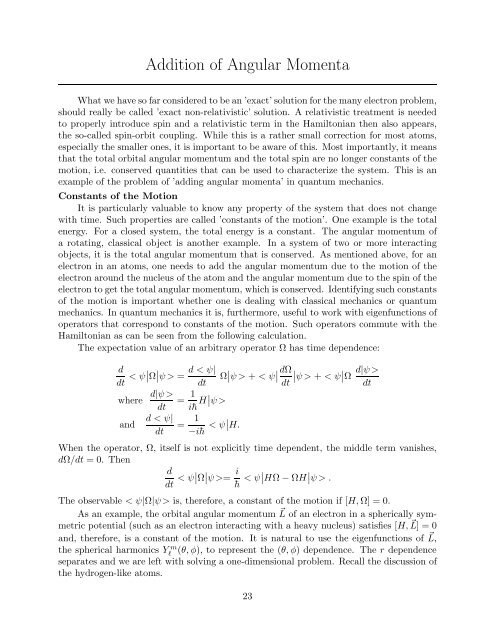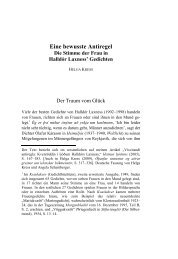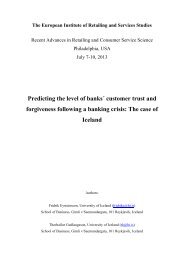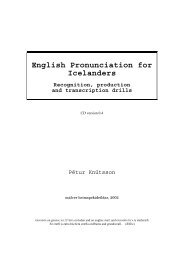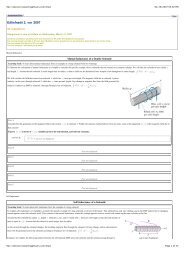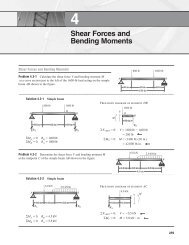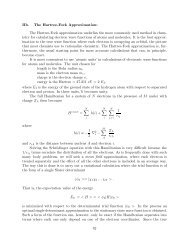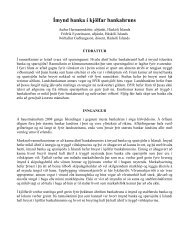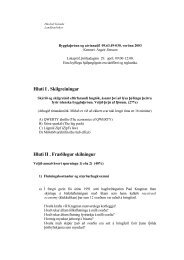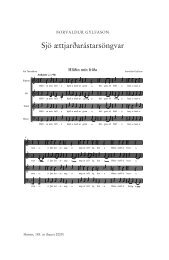Addition of Angular Momenta
Addition of Angular Momenta
Addition of Angular Momenta
You also want an ePaper? Increase the reach of your titles
YUMPU automatically turns print PDFs into web optimized ePapers that Google loves.
<strong>Addition</strong> <strong>of</strong> <strong>Angular</strong> <strong>Momenta</strong><br />
What we have so far considered to be an ’exact’ solution for the many electron problem,<br />
should really be called ’exact non-relativistic’ solution. A relativistic treatment is needed<br />
to properly introduce spin and a relativistic term in the Hamiltonian then also appears,<br />
the so-called spin-orbit coupling. While this is a rather small correction for most atoms,<br />
especially the smaller ones, it is important to be aware <strong>of</strong> this. Most importantly, it means<br />
that the total orbital angular momentum and the total spin are no longer constants <strong>of</strong> the<br />
motion, i.e. conserved quantities that can be used to characterize the system. This is an<br />
example <strong>of</strong> the problem <strong>of</strong> ’adding angular momenta’ in quantum mechanics.<br />
Constants <strong>of</strong> the Motion<br />
It is particularly valuable to know any property <strong>of</strong> the system that does not change<br />
with time. Such properties are called ’constants <strong>of</strong> the motion’. One example is the total<br />
energy. For a closed system, the total energy is a constant. The angular momentum <strong>of</strong><br />
a rotating, classical object is another example. In a system <strong>of</strong> two or more interacting<br />
objects, it is the total angular momentum that is conserved. As mentioned above, for an<br />
electron in an atoms, one needs to add the angular momentum due to the motion <strong>of</strong> the<br />
electron around the nucleus <strong>of</strong> the atom and the angular momentum due to the spin <strong>of</strong> the<br />
electron to get the total angular momentum, which is conserved. Identifying such constants<br />
<strong>of</strong> the motion is important whether one is dealing with classical mechanics or quantum<br />
mechanics. In quantum mechanics it is, furthermore, useful to work with eigenfunctions <strong>of</strong><br />
operators that correspond to constants <strong>of</strong> the motion. Such operators commute with the<br />
Hamiltonian as can be seen from the following calculation.<br />
The expectation value <strong>of</strong> an arbitrary operator Ω has time dependence:<br />
d<br />
dt < ψ∣ ∣<br />
∣ Ω∣ψ> d < ψ| =<br />
dt<br />
where d|ψ><br />
and<br />
dt<br />
d < ψ|<br />
dt<br />
= 1<br />
i¯h H∣ ∣ ψ><br />
= 1<br />
−i¯h < ψ∣ ∣ H.<br />
Ω ∣ ∣ ψ> + < ψ dΩ<br />
∣<br />
∣ ψ> + < ψ∣Ω d|ψ><br />
dt<br />
dt<br />
When the operator, Ω, itself is not explicitly time dependent, the middle term vanishes,<br />
dΩ/dt = 0. Then<br />
d<br />
dt < ψ∣ ∣<br />
∣ Ω∣ψ>= i<br />
¯h < ψ∣ ∣<br />
∣ HΩ − ΩH∣ψ> .<br />
The observable < ψ|Ω|ψ> is, therefore, a constant <strong>of</strong> the motion if [H, Ω] = 0.<br />
As an example, the orbital angular momentum L ⃗ <strong>of</strong> an electron in a spherically symmetric<br />
potential (such as an electron interacting with a heavy nucleus) satisfies [H, L] ⃗ = 0<br />
and, therefore, is a constant <strong>of</strong> the motion. It is natural to use the eigenfunctions <strong>of</strong> L, ⃗<br />
the spherical harmonics Yl m (θ, φ), to represent the (θ, φ) dependence. The r dependence<br />
separates and we are left with solving a one-dimensional problem. Recall the discussion <strong>of</strong><br />
the hydrogen-like atoms.<br />
23
When two angular momenta are present and when there is an interaction between<br />
them, then each one separately will not be a constant <strong>of</strong> the motion. It is then advantageous<br />
to define a new vector, the total angular momentum, which in the absence <strong>of</strong> external<br />
perturbations, is a constant <strong>of</strong> the motion. Following is a discussion <strong>of</strong> two simple but<br />
important examples that illustrate this.<br />
Example 1: Two particles interacting via spherically symmetric potential (for example<br />
the two electrons in a He atom).<br />
The Hamiltonian is<br />
H = H 1 + H 2 + v<br />
where<br />
H 1 = − ¯h2<br />
2m ∇2 1 + V (r 1)<br />
H 2 = − ¯h2<br />
2m ∇2 2 + V (r 2)<br />
v = v(r 12 ) = v(|⃗r 2 − ⃗r 1 |).<br />
We are assuming that each particle is in a force field with spherical symmetry,<br />
V (r 1 ) = V (|⃗r 1 |) and V (r 2 ) = V (|⃗r 2 |).<br />
Therefore, the orbital angular momentum and the Hamiltonian for each particle commute<br />
[L 1 , H 1 ] = [L 2 , H 2 ] = 0.<br />
We also have<br />
[L 1 , H 2 ] = [L 2 , H 1 ] = 0<br />
(L 1 and H 2 act on different variables, and similarly L 2 and H 1 ). Therefore, the individual<br />
angular momenta L 1 and L 2 would be constants <strong>of</strong> the motion, i.e. [L 1 , H] = [L 2 , H] = 0,<br />
if the interaction v(r 12 ) were absent.<br />
Even when the interaction, v, is present, a combination <strong>of</strong> ⃗ L 1 and ⃗ L 2 can be found<br />
that is a constant <strong>of</strong> the motion as long as v only depends on the scalar distance between<br />
the particles<br />
r 12 = |⃗r 1 − ⃗r 2 | = √ (x 1 − x 2 ) 2 + (y 1 − y 2 ) 2 + (z 1 − z 2 ) 2 .<br />
Find: [L 1z , H]:<br />
Using the definition <strong>of</strong> L 1z<br />
L 1z = ¯h i (x ∂ ∂<br />
1 − y 1 )<br />
∂y 1 ∂x 1<br />
24
and the product rule for differentiation gives<br />
[L 1z , H] ψ(⃗r 1 ,⃗r 2 ) = [L 1z , v] ψ = L 1z vψ − vL 1z ψ<br />
= ¯h (<br />
)<br />
∂(vψ) ∂(vψ)<br />
x 1 − y 1 − v¯h (<br />
)<br />
∂ψ ∂ψ<br />
x 1 − y 1<br />
i ∂y 1 ∂x 1 i ∂y 1 ∂x 1<br />
= ¯h (<br />
∂v<br />
x 1 ψ + x 1 v ∂ψ ∂v<br />
− y 1 ψ − y 1 v ∂ψ − x 1 v ∂ψ + y 1 v ∂ψ )<br />
i ∂y 1 ∂y 1 ∂x 1 ∂x 1 ∂y 1 ∂x 1<br />
= ¯h (<br />
)<br />
∂v ∂v<br />
x 1 − y 1 ψ(⃗r 1 ,⃗r 2 )<br />
i ∂y 1 ∂x 1<br />
= ¯h (<br />
)<br />
y 1 − y 2<br />
x 1 v ′ x 1 − x 2<br />
(r 12 ) − y 1 v ′ (r 12 ) ψ(⃗r 1 ,⃗r 2 )<br />
i r 12 r 12<br />
= ¯h i (y 1x 2 − x 1 y 2 ) v′ (r 12 )<br />
ψ(⃗r 1 ,⃗r 2 ).<br />
r 12<br />
The derivatives <strong>of</strong> v can be found using the chain rule<br />
∂v(r 12 )<br />
∂y 1<br />
= ∂r 12<br />
∂y 1<br />
∂v(r 12 )<br />
∂r 12<br />
= y 1 − y 2<br />
r 12<br />
v ′ (r 12 )<br />
with v ′ denoting the derivative <strong>of</strong> the potential function v(α) with respect to the argument<br />
α. Therefore, in operator form,<br />
[<br />
L1z , H ] = ¯h i (Y 1X 2 − X 1 Y 2 ) v′ (r 12 )<br />
r 12<br />
≠ 0.<br />
When the interaction v(r 12 ) is present, L 1z is no longer a constant <strong>of</strong> the motion. Similarly,<br />
[<br />
L2z , H ] = ¯h i (Y 2X 1 − X 2 Y 1 ) v′ (r 12 )<br />
r 12<br />
.<br />
However, if the two results are added together to obtain a commutator for L 1z + L 2z<br />
[<br />
L1z + L 2z , H ] = ¯h v(r 12 )<br />
(Y 1 X 2 − X 1 Y 2 + Y 2 X 1 − X 2 Y 1 )<br />
i r 12<br />
= 0.<br />
The sum L 1z + L 2z is a constant <strong>of</strong> the motion. Similarly we could show that L 1y + L 2y<br />
and L 1x + L 2x are also constants <strong>of</strong> the motion. Therefore, we can define a new vector<br />
⃗L ≡ ⃗ L 1 + ⃗ L 2 which is a constant <strong>of</strong> the motion. The commutation relations for the<br />
25
components <strong>of</strong> this new vector are<br />
[L x , L y ] = [L 1x + L 2x , L 1y + L 2y ]<br />
and, similarly,<br />
= [L 1x , L 1y ] + [L 1x , L 2y ] + [L 2x , L 1y ] + [L 2x , L 2y ]<br />
= i¯h L 1z + i¯h L 2z<br />
= i¯h L z<br />
[L y , L z ] = i¯h L x<br />
and<br />
[L z , L x ] = i¯h L y .<br />
So, by definition, ⃗ L is an angular momentum. It is the total angular momentum. If the two<br />
particles start out in an eigenstate <strong>of</strong> ⃗ L, they will remain in that state unless the system<br />
is perturbed. The problem <strong>of</strong> ’adding angular momenta’ involves finding those states in<br />
terms <strong>of</strong> the eigenstates <strong>of</strong> ⃗ L 1 and ⃗ L 2 .<br />
In classical mechanics the situation is analogous. Total angular momentum <strong>of</strong> two<br />
interacting particles is constant but not the angular momentum <strong>of</strong> each particle separately<br />
if the two interact. But, we usually do not have the problem <strong>of</strong> basis set transformations<br />
in classical mechanics.<br />
Example 2: A particle with spin moving in a central potential v(r) in the presence <strong>of</strong><br />
spin-orbit coupling.<br />
First <strong>of</strong> all, if the Hamiltonian is simply<br />
H = − ¯h2<br />
2m ∇2 + v(r)<br />
then [ ⃗ L, H] = 0 and [ ⃗ S, H] = 0. That is, the two angular momenta are separately constants<br />
<strong>of</strong> the motion if the Hamiltonian does not couple ⃗ L and ⃗ S.<br />
But in relativistic quantum mechanics the spin and orbital angular momenta turn out<br />
to be interacting, or, equivalently, they are coupled together. The interaction is called<br />
spin-orbit coupling and has the form<br />
⃗L · ⃗S = L x S x + L y S y + L z S z .<br />
In the electronic states <strong>of</strong> atoms, this leads to the various terms and term symbols which<br />
are a more rigorous description <strong>of</strong> the state <strong>of</strong> the atom than electron configuration. The<br />
electron configuration does not take into account spin-orbit coupling. It turns out that<br />
the coupling strength is a function <strong>of</strong> the distance to the origin, ζ(r). Thus, the full<br />
Hamiltonian including spin-orbit coupling can be written as<br />
H = − ¯h2<br />
2m ∇2 + v(r) + ζ(r) ⃗ L · ⃗S.<br />
26
Due to the spin-orbit coupling the orbital angular momentum ⃗ L is no longer a constant<br />
<strong>of</strong> the motion. The commutator for the z component, for example, is<br />
[L z , H] = ζ [L z , L x S x + L y S y + L z S z ]<br />
= ζ (S x [L z , L x ] + S y [L z , L y ] + S z [L z , L z ])<br />
= ζ (S x i¯hL y + S y (−i¯hL x ))<br />
= ζ i¯h(S x L y − S y L x )<br />
≠ 0<br />
Similarly, the spin ⃗ S is no longer a constant <strong>of</strong> the motion.<br />
[S z , H] = ζ i¯h(L x S y − L y S x )<br />
≠ 0.<br />
However, the z-component <strong>of</strong> the sum <strong>of</strong> the two angular momentum vectors, ⃗ L z + ⃗ S z ,<br />
is a constant <strong>of</strong> the motion as can be seen by adding the two commutators above,<br />
[L z + S z , H] = 0.<br />
Similar calculation can be done for the x and y components. Therefore, the total angular<br />
momentum ⃗ J ≡ ⃗ L + ⃗ S is a constant <strong>of</strong> the motion. Again, we can easily show that ⃗ J<br />
satisfies the commutation relations that define an angular momentum vector<br />
[J x , J y ] = i¯hJ z , etc.<br />
The Hamiltonians in examples 1 and 2 are common. Working with the eigenstates <strong>of</strong><br />
the total angular momentum rather than the eigenstates <strong>of</strong> the individual angular momenta<br />
greatly simplifies calculations is such cases. The problem <strong>of</strong> ‘addition <strong>of</strong> angular momenta’<br />
therefore involves more than just addition <strong>of</strong> two vectors, we need to find the eigenstates <strong>of</strong><br />
the total angular momentum and express them in terms <strong>of</strong> the already known eigenstates<br />
<strong>of</strong> the individual angular momenta.<br />
Definition <strong>of</strong> Clebsch-Gordan coefficients:<br />
The general problem can be stated in the following way: Given two angular momenta<br />
L ⃗ and S ⃗ (not necessarily orbital and spin angular momenta, here L ⃗ and S ⃗ are<br />
used as general symbols for any two angular momenta) and their eigenkets |lm l > and<br />
|sm s >, a complete set <strong>of</strong> eigenkets for the combined system can be constructed by direct<br />
multiplication<br />
|lsm l m s >≡ |lm l > ⊗|sm s > .<br />
This is a complete set and forms a basis but these kets do not correspond to a constant<br />
<strong>of</strong> the motion. Instead, one would like to transform to a new set <strong>of</strong> kets |jm > that<br />
27
correspond to eigenstates <strong>of</strong> J 2 , J z , L 2 and S 2 where the total angular momentum is<br />
defined as ⃗ J ≡ ⃗ L + ⃗ S. That is, the new kets should satisfy<br />
J 2 |jm>= j(j + 1)¯h 2 |jm><br />
J z |jm>= m¯h|jm><br />
L 2 |jm>= l(l + 1)¯h 2 |jm><br />
and<br />
S 2 |jm>= s(s + 1)¯h 2 |jm> .<br />
The new vectors can be constructed from the direct product basis<br />
|jm>=<br />
l∑<br />
s∑<br />
m l =−l m s =−s<br />
a lsml m s ;jm|lsm l m s ><br />
and the problem reduces to finding the linear combination coefficients a lsml m s ;jm =<<br />
lsm l m s |jm> which are called Clebsch-Gordan coefficients. They have been tabulated in<br />
may books and are also preprogrammed in various mathematical s<strong>of</strong>tware packages.<br />
Solution for Two Spin 1/2 Particles:<br />
The general method for finding eigenstates <strong>of</strong> the total angular momentum is a bit<br />
involved and it is worthwhile to illustrate the essence <strong>of</strong> the problem in the simple but<br />
important case <strong>of</strong> two spin 1 angular momenta. Here a straight forward application <strong>of</strong><br />
2<br />
linear algebra will do the job. Later, this same problem will be solved using the general<br />
method, and finally the general solution will be presented.<br />
The total spin angular momentum is S ⃗ ≡ S ⃗ 1 + S ⃗ 2 . We want to find a set <strong>of</strong> states<br />
|sm > such that S ⃗2 |sm >= s(s + 1)¯h 2 |sm > and S z |sm >= m¯h|sm >. We will express<br />
them as linear combinations <strong>of</strong> the direct products <strong>of</strong> eigenstates <strong>of</strong> S ⃗ 1 and eigenstates <strong>of</strong><br />
⃗S 2 :<br />
|sm>= a | + +> + b | + −> + c | − +> + d | − −> .<br />
The direct product states satisfy<br />
S 1z | + +> = ¯h 2 | + +><br />
S 1z | + −> = ¯h 2 | + −><br />
S 1z | − +> = −¯h 2 | − +><br />
S 1z | − −> = −¯h 2 | − −><br />
28
and similar relationships for S 2z . The length <strong>of</strong> the two spin vectors is necessarily the same<br />
S 2 1| ± ±> = S 2 2| ± ±> = 3¯h2<br />
4 | ± ±> .<br />
Using the direct product states as basis (in the same order as above), the state |sm><br />
can be expressed in vector notation as<br />
⎛ ⎞<br />
a<br />
⎜ b ⎟<br />
|sm>= ⎝ ⎠.<br />
c<br />
d<br />
First, we will find 4x4 matrices representing the operators S 2 and S z and then by<br />
diagonalizing, get the eigenvectors |sm>.<br />
Matrix for S z :<br />
We need to evaluate all the matrix elements <strong>of</strong> S z in this basis.<br />
⎛<br />
⎞<br />
< + + |S z | + +> < + + |S z | + −> < + + |S z | − +> < + + |S z | − −><br />
⎜ < + − |S<br />
S z =<br />
z | + +> < + − |S z | + −> . . . . . . ⎟<br />
⎝<br />
⎠ .<br />
< − + |S z | + +> . . . . . . . . .<br />
< − − |S z | + +> . . . . . . < − − |S z | − −><br />
First, applying the operator to | + + ><br />
the first column is<br />
S z | + +>= S 1z | + +> +S 2z | + +>=<br />
< + + |S z | + +> = ¯h<br />
< + − |S z | + +> = 0<br />
< − + |S z | + +> = 0<br />
< − − |S z | + +> = 0.<br />
The second and third columns only have zeros because<br />
(¯h<br />
S z | + −> =<br />
2 − ¯h | + −>= 0<br />
2)<br />
and<br />
S z | − +> =<br />
(<br />
−¯h 2 + ¯h )<br />
2<br />
(¯h<br />
2 + ¯h 2)<br />
| + +>= ¯h| + +><br />
| − +>= 0.<br />
The fourth column has one non-zero element just like the first column,<br />
(<br />
S z | − −> = −¯h 2 − ¯h )<br />
| − −>= −¯h | − −> .<br />
2<br />
29
The full matrix is<br />
⎛ ⎞<br />
¯h 0 0 0<br />
⎜ 0 0 0 0 ⎟<br />
S z = ⎝ ⎠ .<br />
0 0 0 0<br />
0 0 0 −¯h<br />
This is already diagonal, i.e., the basis vectors | ± ±> are eigenvectors <strong>of</strong> S z . Any linear<br />
combination that only mixes the | + −> and | − +> vectors will also be an eigenvector.<br />
Matrix for S 2 :<br />
By definition <strong>of</strong> the total angular momentum, we have<br />
S 2 = ⃗ S · ⃗S = ( ⃗ S 1 + ⃗ S 2 ) · ( ⃗ S 1 + ⃗ S 2 ) = S 2 1 + S2 2 + 2⃗ S 1 · ⃗S 2 .<br />
The action <strong>of</strong> the S 2 1 and S 2 2 operators can be readily evaluated but we need a convenient<br />
expression for ⃗ S 1 · ⃗S 2 so that the action <strong>of</strong> this operator on the direct basis functions can<br />
be evaluated. Written in terms <strong>of</strong> the Cartesian components<br />
⃗S 1 · ⃗S 2 = S 1x S 2x + S 1y S 2y + S 1z S 2z<br />
The action <strong>of</strong> the last term, S 1z S 2z , on the direct product states can easily be evaluated, but<br />
the first two terms involving the x and y components are not as straight forward because<br />
the direct product states are not eigenstates <strong>of</strong> those operators. Since we have chosen to<br />
know the projection <strong>of</strong> the spin on the z-axis, the projection onto the y− and x−axes is<br />
not known. It is convenient here to make use <strong>of</strong> the raising and lowering operators for<br />
angular momentum to rewrite S 1x and S 1y as<br />
S 1x = 1 2 (S 1+ + S 1− )<br />
S 1y = 1 2i (S 1+ − S 1− )<br />
and similarly for the S 2x and S 2y operators. Using this, the ⃗ S 1 · ⃗S 2 operator can be written<br />
as<br />
⃗S 1 · ⃗S 2 == 1 2 (S 1+S 2− + S 1− S 2+ ) + S 1z S 2z .<br />
First find the matrix representation for the S 1z S 2z part:<br />
(¯h<br />
S 1z S 2z | + +> =<br />
2<br />
S 1z S 2z | + −> =<br />
S 1z S 2z | − +> =<br />
S 1z S 2z | − −> =<br />
) ) 2 (¯h<br />
(¯h<br />
| + +>= | + +><br />
2)<br />
2<br />
(¯h<br />
2)(<br />
−¯h )<br />
) 2 (¯h<br />
| + −>= − | + −><br />
2<br />
2<br />
(<br />
−¯h ) 2 )(¯h<br />
(¯h<br />
| − +>= − | − +><br />
2 2)<br />
2<br />
(<br />
−¯h )(<br />
−¯h ) ) 2 (¯h<br />
| − −>= | − −> .<br />
2 2 2<br />
30
Left multiplying with each <strong>of</strong> the basis vectors gives a diagonal matrix<br />
⎛<br />
⎞<br />
) 1 0 0 0<br />
2 (¯h ⎜ 0 −1 0 0 ⎟<br />
S 1z S 2z = ⎝<br />
⎠ .<br />
2 0 0 −1 0<br />
0 0 0 1<br />
Then, find the matrix representation <strong>of</strong> the (S 1+ S 2− +S 1− S 2+ ) part: The first column<br />
only has zeros, since<br />
(S 1+ S 2− + S 1− S 2+ ) | + +> = S 1+ S 2− | + +> +S 1− S 2+ | + +><br />
= ¯hS 1+ | + −> + 0<br />
= 0 .<br />
Similarly, the fourth column only has zeros,<br />
(S 1+ S 2− + S 1− S 2+ ) | − −> = 0 .<br />
However the second and third column have one non-zero element<br />
(S 1+ S 2− + S 1− S 2+ ) | + −> = S 1+ S 2− | + −> +S 1− S 2+ | + −><br />
and<br />
= 0 + ¯hS 1− | + +><br />
= ¯h 2 | − +><br />
(S 1+ S 2− + S 1− S 2+ ) | − +> = S 1+ S 2− | − +> +S 1− S 2+ | − +><br />
= ¯hS 1+ | − −> +0<br />
= ¯h 2 | + −> .<br />
Left multiplying with each <strong>of</strong> the basis vectors gives the matrix<br />
The S 2 1 and S2 2<br />
⎛ ⎞<br />
0 0 0 0<br />
⎜ 0 0 ¯h 2 0⎟<br />
S 1+ S 2− + S 1− S 2+ = ⎝<br />
0 ¯h 2 ⎠<br />
0 0<br />
0 0 0 0<br />
matrices are simple:<br />
⎛ ⎞<br />
1 0 0 0<br />
S1 2 = S2 2 = 3 ⎜0 1 0 0⎟<br />
4¯h2 ⎝ ⎠ .<br />
0 0 1 0<br />
0 0 0 1<br />
Adding the various contributions finally gives:<br />
⎛ ⎞<br />
2 0 0 0<br />
S 2 = ¯h 2 ⎜0 1 1 0⎟<br />
⎝ ⎠ .<br />
0 1 1 0<br />
0 0 0 2<br />
31
We need to find linear combinations <strong>of</strong> the | ± ±> that make both the S z and the S 2<br />
matrices diagonal. We will diagonalize the S 2 matrix and find that the eigenvectors heppen<br />
to be also eigenvectors <strong>of</strong> S z . Let |sm > denote the eigenvectors and define λ ≡ s(s + 1).<br />
Then S 2 |sm> −λ¯h 2 |sm>= 0, or in matrix form<br />
⎛<br />
¯h 2 ⎜<br />
⎝<br />
2 − λ 0 0 0<br />
0 1 − λ 1 0<br />
0 1 1 − λ 0<br />
0 0 0 2 − λ<br />
This has non-trivial solutions (i.e. (abcd) ≠ 0) when<br />
det<br />
⎛<br />
⎜<br />
⎝<br />
⎞<br />
⎟<br />
⎠<br />
⎛<br />
⎜<br />
⎝<br />
a<br />
b<br />
c<br />
d<br />
⎞<br />
⎟<br />
⎠ = 0 .<br />
⎞<br />
2 − λ 0 0 0<br />
0 1 − λ 1 0 ⎟<br />
⎠ = 0.<br />
0 1 1 − λ 0<br />
0 0 0 2 − λ<br />
Expanding the determinant gives<br />
(2 − λ) 2 det<br />
( )<br />
1 − λ 1<br />
= 0<br />
1 1 − λ<br />
(2 − λ) 2 ((1 − λ) 2 − 1) = 0.<br />
This is a fourth order equation for λ, with four roots. From the first factor we get twice<br />
the solution λ = 2 which gives s = 1. From the second factor we get 1 − 2λ + λ 2 − 1 = 0,<br />
i.e., λ = 0 meaning s = 0 and λ = 2 meaning s = 1 once more. So s has two possible<br />
values: 0 which is non-degenerate, and 1 which is threefold degenerate.<br />
Find the corresponding eigenvectors:<br />
For s = 0: (λ = 0)<br />
⎛ ⎞ ⎛<br />
2 0 0 0<br />
⎜ 0 1 1 0⎟<br />
⎜<br />
⎝ ⎠ ⎝<br />
0 1 1 0<br />
0 0 0 2<br />
This gives a = 0, d = 0 and b + c = 0, i.e., b = −c.<br />
Normalized, the eigenvector is<br />
⎛<br />
1 ⎜<br />
√ ⎝ 2<br />
0<br />
1<br />
−1<br />
0<br />
⎞<br />
a<br />
b<br />
c<br />
d<br />
⎞<br />
⎟<br />
⎠ = 0.<br />
⎟<br />
⎠ = √ 1 (| + −> − | − +>).<br />
2<br />
Since only the | + − > and | − + > states get mixed here, this new vector remains an<br />
eigenvector <strong>of</strong> S z . This nondegenerate eigenstate is called the singlet.<br />
For s = 1: (λ = 2)<br />
32
⎛<br />
0 0 0 0<br />
⎜ 0 −1 1 0<br />
⎝<br />
0 1 −1 0<br />
0 0 0 (2 − 2)<br />
⎞<br />
⎟<br />
⎠<br />
⎛<br />
⎜<br />
⎝<br />
a<br />
b<br />
c<br />
d<br />
⎞<br />
⎟<br />
⎠ = 0.<br />
This gives b − c = 0.<br />
Since this is a threefold degenerate eigenvalue, we need three linearly independent<br />
eigenvectors. Given that there is no constraint on a, we can easily generate one normalized<br />
eigenvector by taking a = 1 and b = c = d = 0. This is simply the |++> state. Similarly,<br />
we can take d = 1 and a = d = c = 0. This is the | − −> state. For the third eigenvector,<br />
we must have a = 0 and b = 0 since it must be linearly independent <strong>of</strong> the first two. We<br />
are then left with the condition b = c, and the normalized vector is 1 √<br />
2<br />
(|+−> +| −+>).<br />
Again, since only the | + −> and | − +> states get mixed here, this is vector is also an<br />
eigenvector <strong>of</strong> S z . This triply degenerate eigenvalue is called the triplet.<br />
Summary:<br />
The solutions are the states |sm> with the following values for the quantum numbers<br />
and expansions in the direct product basis vectors:<br />
The singlet state, s = 0 has m = 0 and is |00>= √ 1<br />
2<br />
(| + −> −| − +>).<br />
The triplet state, s = 1 has<br />
m = 1 |11> = | + +><br />
m = 0 |10> = √ 1 (| + −> + | − +>)<br />
2<br />
m = −1 |1 − 1> = | − −> .<br />
These four vectors form a basis and are simultaneously eigenvectors <strong>of</strong> both S 2 and<br />
S z (as well as S 2 1 and S2 2 ).<br />
Time Evolution <strong>of</strong> Coupled Spin 1/2 Particles: (CDL F X )<br />
To illustrate the significance <strong>of</strong> the preceding result, consider two spin 1 2<br />
are coupled by the interaction aS ⃗ 1 · ⃗S 2 , i.e., the Hamiltonian is:<br />
H = H 1 + H 2 + a ⃗ S 1 · ⃗S 2 .<br />
particles that<br />
The direct product states | ± ±> are eigenstates <strong>of</strong> the independent particle Hamiltonian<br />
H 0 = H 1 + H 2 . However, when the interaction W is turned on, those are no longer<br />
eigenstates. Therefore, even if the state <strong>of</strong> the system is, for example, as | + −> at time<br />
t = 0, the orientations <strong>of</strong> the spins will have reversed some time later and the system can<br />
be described as | − +>. This can be illustrated with a simple calculation.<br />
The time independent, stationary states are the eigenstates <strong>of</strong> the total angular momentum<br />
|sm>= |00>, |11>, |10> and |1 − 1>. In order to express the time evolution <strong>of</strong><br />
33
an arbitrary state, we need the energies <strong>of</strong> the stationary states. We need to evaluate the<br />
coupling term which can be rewritten as<br />
W = a ⃗ S 1 · ⃗S 2 = a 2<br />
[<br />
S 2 − S1 2 − S2] 2 a =<br />
[S 2 − 3 ]<br />
2 2¯h2<br />
Since there are two possible values for s, s = 0 and s = 1, there are two distinct energy<br />
levels:<br />
W |00>= a [0 − 3 ]<br />
2 2¯h2 |00>= − 3a 4 ¯h2 |00>≡ E − |00><br />
and<br />
W |1m>= a 2<br />
[2¯h 2 − 3 ]<br />
2¯h2 = a 4¯h2 |1m>≡ E + |1m> .<br />
The higher energy level, E + = a¯h 2 /4, is threefold degenerate while the lower level E − =<br />
−3a¯h 2 /4, is non-degenerate.<br />
Lets assume that initially, at t = 0, the state is<br />
|ψ> (0) = | + −> .<br />
From the previous result, we can see that this can be rewritten in terms <strong>of</strong> the stationary<br />
states as<br />
1<br />
√<br />
2<br />
(|10> + |00>) .<br />
At a later time t the state is<br />
|ψ> (t) = √ 1<br />
]<br />
[e −ia¯ht/4 |10> + e i3a¯ht/4 |00> .<br />
2<br />
34
In particular, at time t = π/a¯h we have<br />
[<br />
]<br />
|ψ> (π/a¯h) = e −iπ/4 |10> + e i3π/4 |00><br />
= 1 √<br />
2<br />
e −iπ/4 [|10> +e iπ |00>]<br />
= 1 √<br />
2<br />
e −iπ/4 [|10> −|00>]<br />
= e −iπ/4 | − +><br />
i.e., the spins have reversed their orientation from the initial state at t = 0.<br />
General Method:<br />
The direct diagonalization used above to solve the problem involving two spin 1 2 particles<br />
does not lend itself well to generalizations. The solution for adding any two angular<br />
momentum vectors can be expressed more explicitly by using another, somewhat more involved<br />
procedure. This procedure makes use <strong>of</strong> the fact that the total angular momentum<br />
satisfies the general properties <strong>of</strong> angular momenta, in particular the restrictions on the<br />
possible values <strong>of</strong> the quantum numbers s and m. It is most simply illustrated by solving<br />
again the addition <strong>of</strong> two angular momenta with s 1 = s 2 = 1 2 .<br />
Example: Again, do two spin 1 2 particles.<br />
As we saw in the previous solution to this problem, the vectors |++>, |+−>, |−+><br />
and | − −> (the direct product vectors) are already eigenstates <strong>of</strong> S z . The eigenvalues are<br />
m = m 1 + m 2 . Here m can be −1, 0 and 1, with 0 being tw<strong>of</strong>old degenerate.<br />
In forming the linear combinations<br />
|sm>= a | + +> + b | + −> + c | − +> + d | − −><br />
we must not mix states with unequal m, otherwise the resulting vector will not be eigenvector<br />
<strong>of</strong> S z . This means we can only mix | + −> and | − +>. The possible values <strong>of</strong> m<br />
35
are therefore the same as the values <strong>of</strong> m 1 + m 2 . Letting m 1 and m 2 run over all possible<br />
values, the value <strong>of</strong> m 1 + m 2 is 1 once, −1 once and 0 twice.<br />
No value <strong>of</strong> m is larger than 1. Since we know that m will take any value in the<br />
range −s ≤ m ≤ s, this means we cannot have s larger than 1. The value m 1 + m 2 = 1<br />
does appear once, so we must have one total angular momentum state with m = 1. This<br />
means states with s = 1 exist with |11> being one <strong>of</strong> them. The expansion <strong>of</strong> this state<br />
in the direct product basis is easy to find since only one <strong>of</strong> those has m 1 + m 2 = 1,<br />
a = 1, b = c = d = 0. Therefore, |11>= |++>. Again, using the fact that m will take all<br />
values in the range −s ≤ m ≤ s, we must have two other states corresponding to s = 1,<br />
namely |10> and |1 −1 >. We can obtain both <strong>of</strong> these by applying the lowering operator<br />
S − to |11>. From the general properties <strong>of</strong> angular momenta we get:<br />
S − |11>= ¯h √ 1(1 + 1) − 1(1 − 1) |10>= ¯h √ 2 |10> .<br />
Equivalently, applying the lowering operator in the direct product representation gives<br />
S − |11>= (S 1− + S 2− | + +>= ¯h (| − +> + | + −>).<br />
Subtracting the two equations gives the m = 0 state<br />
|10>= 1 √<br />
2<br />
(| − +> + | + −>).<br />
Applying S − again gives the m = −1 state:<br />
S − |10>= ¯h √ 1(1 + 1) − 0(0 − 1) |1 − 1>= ¯h √ 2 |1 − 1><br />
Equivalently, using the direct product basis<br />
S − |10> = (S 1− + S 2− )<br />
1<br />
√<br />
2<br />
(| − +> + | + −>)<br />
= ¯h √<br />
2<br />
(| − −> + | − −>) = ¯h √ 2 | − −> .<br />
Subtracting the two equations, we have<br />
|1 − 1> = | − −> .<br />
There is only one more state to be found (the total must be four) and the only one <strong>of</strong><br />
the possible values <strong>of</strong> m not accounted for is the second occurance <strong>of</strong> m 1 + m 2 = 0 = m.<br />
This state must have s = 0 and is therefore the |00 > state. Expressed in terms <strong>of</strong> the<br />
direct product basis, only the m = 0 states, namely | + −> and | − +>, can be involved.<br />
Say<br />
|00> = α | + −> + β | − +> .<br />
36
Choosing |00> to be normalized < 00|00>= 1 = |α| 2 + |β| 2 . Furthermore, this state must<br />
be orthogonal to the other states |11>, |10>, and |1 − 1>. In particular, |00> must be<br />
orthogonal to the other m = 0 state<br />
< 00|10> = 0<br />
= 1 √<br />
2<br />
(α ∗ β ∗ )<br />
(<br />
1<br />
1)<br />
Therefore α = −β and<br />
|00>= 1 √<br />
2<br />
(| + −> −| − +>).<br />
The General Solution: J ⃗ ≡ L ⃗ + S ⃗<br />
Given the direct product basis |lsm l m s >, the task is to find eigenvectors <strong>of</strong> J 2 ,J z ,L 2<br />
and S 2 denoted |jm> as linear combinations:<br />
|jm>= ∑ m l<br />
∑<br />
m s<br />
a lsml m s ;jm|lsm l m s > .<br />
Since the new states are eigenvectors <strong>of</strong> L 2 and S 2 with given eigenvalues l and s, the<br />
linear compbination can only involve direct product vectors with those values <strong>of</strong> l and<br />
s. The total number <strong>of</strong> states is (2l + 1)(2s + 1). The direct product states |lsm l m s ><br />
are already eigenvectors <strong>of</strong> J z with eigenvalues m = m l + m s where −l ≤ m l ≤ l and<br />
−s ≤ m s ≤ s. Therefore, m can take the values (l + s), (l + s − 1), . . ., −(l + s).<br />
Example: l = 2 and s = 1<br />
No value <strong>of</strong> m is larger than l + s. Therefore, we cannot have j larger than l + s. We<br />
have one state with m = l + s and since we can only mix states with equal m, that state<br />
must be<br />
j = l + s , m = l + s :<br />
37
| l + s<br />
}{{}<br />
j<br />
l + s<br />
}{{}<br />
m<br />
>= |l s l<br />
}{{}<br />
m l<br />
}{{}<br />
s > .<br />
m s<br />
The choice <strong>of</strong> phase is arbitrary here. This choice, taking the Clebsch-Gordan coefficient<br />
to be real and positive, will ensure that all the coefficients are real.<br />
By applying the lowering operator we can generate 2(l+s)+1 states with j = l+s,<br />
|l+s l+s−1> = J − |l s l s> .<br />
By repeated application <strong>of</strong> J − we finally get to the m = −(l + s) state.<br />
Since the total number <strong>of</strong> states is (2l+ 1)(2s+1), we still have to find (2l+1)(2s+<br />
1)−(2(l+s)+1) more. The states that are left have a maximum m value <strong>of</strong> m = l+s−1<br />
(since the m = l + s state has already been determined). Therefore, we must have states<br />
with j = l + s − 1. We can find the j = l + s − 1, m = l + s − 1 state by taking a<br />
linear combination <strong>of</strong> the two direct product states that have m = l+s−1. Choosing this<br />
state to be normalized and orthogonal to the j = l + s, m = l + s − 1 state determines<br />
the expansion coefficients. Then we can apply J − repeatedly to generate the full set <strong>of</strong><br />
2(l + s − 1) + 1 states corresponding to j = l + s − 1, and so on.<br />
What is the smallest value <strong>of</strong> j? Just counting the number <strong>of</strong> states, which must be<br />
the same in the direct product basis as in the total angular momentum basis, gives an<br />
equation that can be solved to give the minimum j value, denoted here as j 0<br />
∑l+s<br />
j=j 0<br />
(2j + 1) = (2l + 1)(2s + 1)<br />
(l + s)(l + s + 1) − (j 0 − 1)j 0 + l + s − (j 0 − 1) = 4ls + 2l + 2s + 1<br />
j 2 0 = l2 − 2ls + s 2 = (l − s) 2 .<br />
Therefore the minimum value for j is j 0 = |l − s|.<br />
The final result is that j can take the values (l + s), (l + s − 1), . . ., |l − s|. This<br />
means that j must be such that a triangle can be formed with sides l, s, j. Therefore, this<br />
limitation on the range <strong>of</strong> j is called the ‘triangle rule’. Tables <strong>of</strong> the expansion coefficients,<br />
the Clebsch-Gordan coefficients, a lsml m s ;jm can be found in books on angular momentum<br />
(Edmonds, or Rose, or Condon & Shortley). Several computer programs provide the<br />
values <strong>of</strong> the the Clebsch-Gordan coefficients, for example Mathematica. Recursion and<br />
orthogonality relations can be derived for the Clebsch-Gordan coefficients, see CLD B X .<br />
38


